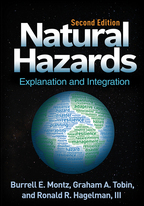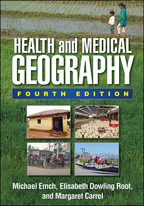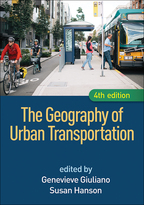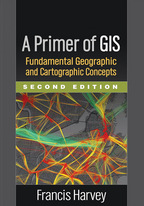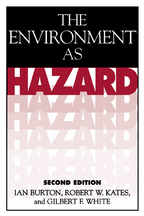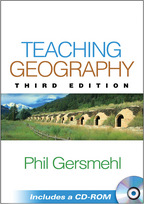Natural Hazards
Second Edition
Explanation and Integration
Burrell E. Montz, Graham A. Tobin, and Ronald R. Hagelman III
HardcoverPaperbacke-bookprint + e-book
Hardcover
orderApril 25, 2017
ISBN 9781462529186
Price: $102.00 445 Pages
Size: 7" x 10"
Paperback
orderApril 26, 2017
ISBN 9781462529179
Price: $68.00445 Pages
Size: 7" x 10"
“This new edition expands on the framework of the first edition and includes new research, techniques, and models developed since the original publication. A notable difference in the updated edition is the separation of physical characteristics of natural hazards into two separate chapters—one on magnitude and intensity aspects and the other on time and spatial relationships. This allows for more description of these elements and gives readers a better baseline for gauging the events and hazards of interest….The text includes many useful tables and charts, and the index is well designed….In addition to advanced students, practitioners—especially those involved in public policy development or planning—will benefit. Recommended. Upper-division undergraduates and above; professionals and practitioners.”

—Choice Reviews
“A book that is both a critique of current hazard management practices and a significant contribution to the continuing theoretical and philosophical debate about the role of humans in natural hazards.”

—Economic Geography (on the first edition)
“[This book] is an excellent introduction to the subject for college and graduate students and is also, in itself, a fine example of how the physical, biological, and social sciences can be combined into an explanatory model.”

—Science Books and Films (on the first edition)
“A welcome update. Maintaining the original framework, the second edition of this text integrates the temporal and spatial aspects of hazards while eschewing a hazard-by-hazard approach. Synthetic in nature, the examples bridge the physical, social, and behavioral sciences, and reflect important advances in thinking about vulnerability as well as newer concerns such as climate change. More than just descriptive, Natural Hazards provides clear prescriptions for reducing vulnerability to disastrous events. I look forward to using this text in my upper-level undergraduate hazards course.”

—Jerry T. Mitchell, PhD, Department of Geography, University of South Carolina
“This is the most comprehensive and up-to-date text on the nature and mitigation of natural hazards. It approaches natural disasters by focusing on their root causes, including hazard perception and behavior, topics missing from most current texts. The book presents a model of risk that strikes a balance between the physical mechanisms and the human dimension of natural hazards and considers available coping strategies as an essential element. I plan to adopt this text for my class.”

—Qian Guo, PhD, Department of Geography and Environment, San Francisco State University
“Montz, Tobin, and Hagelman use the lenses of both the physical and social sciences to provide an interdisciplinary examination of a multifaceted topic. The book describes the relationship of humans to natural hazards at multiple scales—from individuals to communities to nations—while being ever mindful that knowledge should serve as a basis for action. The book is filled with international examples, as well as dozens of charts and tables that measure hazards and vulnerability in every way possible. This comprehensive and readable review is the most complete introduction I know of to this field.”

—Robert B. Olshansky, PhD, FAICP, Department of Urban and Regional Planning, University of Illinois at Urbana–Champaign
“This particularly rich volume brings together three outstanding scholars dedicated to reducing loss of life, property damage, and expenses related to disasters. Expertly combining an understanding of physically situated risks and their related human impacts, the text walks readers through how and why natural hazards create disasters. It is deeply embedded in evidence-based best practices and well poised to generate theoretical and practical insights.”

—Brenda Phillips, PhD, Associate Dean and Professor of Sociology, Ohio University–Chillicothe
“Combining the study of physical features of natural hazards with the complicated role of human interaction, this 'must-read' book offers a unique perspective for all emergency managers, regardless of specialty. It provides the best summary of where the field has been, highlights past lessons learned from national and international disasters, and discusses the current accepted cycle of recovery. The critique of governmental entities at the local, state, and federal levels, and the emphasis on positive public policy support of mitigation practices and risk reduction–focused leadership, also make this a valuable book for public administrators.”

—Charla Marchuk, MPA, CFM, natural hazards specialist, Denton, Texas
“Natural Hazards, Second Edition, should be required reading for emergency management practitioners. Emergency managers come from a multitude of backgrounds, with very few from geography or other disciplines related to understanding how natural hazards work. This book provides an in-depth examination of the interdisciplinary fields deployed in emergency management and ties them all together. It is a vastly useful resource that is up to date, clear, and straightforward.”

—Brad Bartholomew, MPP, Mitigation and Recovery Section Manager and State Hazard Mitigation Officer, Utah Emergency Management
—Choice Reviews
“A book that is both a critique of current hazard management practices and a significant contribution to the continuing theoretical and philosophical debate about the role of humans in natural hazards.”
—Economic Geography (on the first edition)
“[This book] is an excellent introduction to the subject for college and graduate students and is also, in itself, a fine example of how the physical, biological, and social sciences can be combined into an explanatory model.”
—Science Books and Films (on the first edition)
“A welcome update. Maintaining the original framework, the second edition of this text integrates the temporal and spatial aspects of hazards while eschewing a hazard-by-hazard approach. Synthetic in nature, the examples bridge the physical, social, and behavioral sciences, and reflect important advances in thinking about vulnerability as well as newer concerns such as climate change. More than just descriptive, Natural Hazards provides clear prescriptions for reducing vulnerability to disastrous events. I look forward to using this text in my upper-level undergraduate hazards course.”
—Jerry T. Mitchell, PhD, Department of Geography, University of South Carolina
“This is the most comprehensive and up-to-date text on the nature and mitigation of natural hazards. It approaches natural disasters by focusing on their root causes, including hazard perception and behavior, topics missing from most current texts. The book presents a model of risk that strikes a balance between the physical mechanisms and the human dimension of natural hazards and considers available coping strategies as an essential element. I plan to adopt this text for my class.”
—Qian Guo, PhD, Department of Geography and Environment, San Francisco State University
“Montz, Tobin, and Hagelman use the lenses of both the physical and social sciences to provide an interdisciplinary examination of a multifaceted topic. The book describes the relationship of humans to natural hazards at multiple scales—from individuals to communities to nations—while being ever mindful that knowledge should serve as a basis for action. The book is filled with international examples, as well as dozens of charts and tables that measure hazards and vulnerability in every way possible. This comprehensive and readable review is the most complete introduction I know of to this field.”
—Robert B. Olshansky, PhD, FAICP, Department of Urban and Regional Planning, University of Illinois at Urbana–Champaign
“This particularly rich volume brings together three outstanding scholars dedicated to reducing loss of life, property damage, and expenses related to disasters. Expertly combining an understanding of physically situated risks and their related human impacts, the text walks readers through how and why natural hazards create disasters. It is deeply embedded in evidence-based best practices and well poised to generate theoretical and practical insights.”
—Brenda Phillips, PhD, Associate Dean and Professor of Sociology, Ohio University–Chillicothe
“Combining the study of physical features of natural hazards with the complicated role of human interaction, this 'must-read' book offers a unique perspective for all emergency managers, regardless of specialty. It provides the best summary of where the field has been, highlights past lessons learned from national and international disasters, and discusses the current accepted cycle of recovery. The critique of governmental entities at the local, state, and federal levels, and the emphasis on positive public policy support of mitigation practices and risk reduction–focused leadership, also make this a valuable book for public administrators.”
—Charla Marchuk, MPA, CFM, natural hazards specialist, Denton, Texas
“Natural Hazards, Second Edition, should be required reading for emergency management practitioners. Emergency managers come from a multitude of backgrounds, with very few from geography or other disciplines related to understanding how natural hazards work. This book provides an in-depth examination of the interdisciplinary fields deployed in emergency management and ties them all together. It is a vastly useful resource that is up to date, clear, and straightforward.”
—Brad Bartholomew, MPP, Mitigation and Recovery Section Manager and State Hazard Mitigation Officer, Utah Emergency Management

